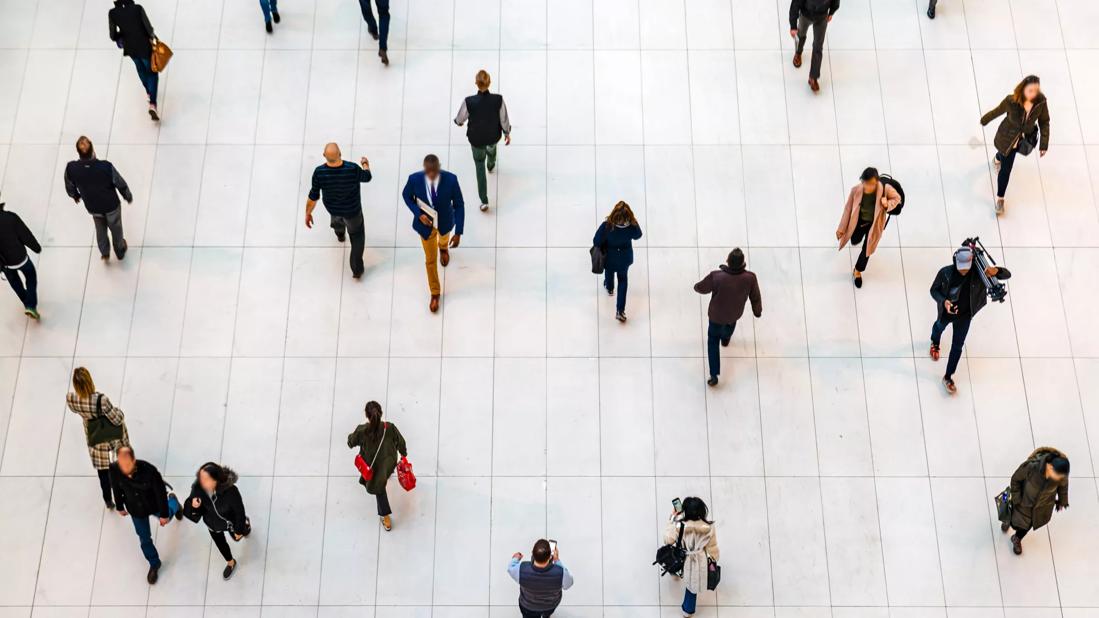The short answer: It’s complicated, but the basic care precautions still prevail, like washing your hands and isolating if you’re sick

Do you remember the sourdough days of the early COVID-19 pandemic? Can you recall the hand sanitizer shortages and resulting DIY concoctions? Wiping down your groceries with disinfectant? Dangerous claims that colloidal silver could prevent COVID — and cow urine could cure it?
Advertisement
Cleveland Clinic is a non-profit academic medical center. Advertising on our site helps support our mission. We do not endorse non-Cleveland Clinic products or services. Policy
So much has changed, in such a short time. We’re still living with COVID-19 — and people are still dying of it. But the world has opened back up. And with a few notable exceptions, we’re back to business as usual. We owe that, in part, to rising levels of COVID immunity.
But what exactly does “COVID immunity” mean? Is being vaccinated the same thing as being immune? And what about people who are immunocompromised?
We asked family medicine specialist Neha Vyas, MD, to help us answer some of the most common questions about COVID immunity.
Given the sheer volume of people who became sick with or died of COVID-19 in the early days of the pandemic, you might think that all active healthcare workers and first responders got sick. And you’d be mostly right. Mostly.
While their numbers are small, to be sure, there are people out there who — despite being exposed to COVID-19 regularly for years — have never contracted the virus. And some of those people have weak immune systems!
It raises the question: Is it possible that some people have a genetic mutation that makes them immune, or resistant, to COVID-19?
According to the Association of American Medical Colleges, scientists are working hard to find out.
Advertisement
It’s an interesting topic to study because recent research has demonstrated that genetics can make people more vulnerable to the virus. A 2022 study in Nature found that somewhere between 5% and 10% of critical pneumonia cases in children with COVID-19 could be explained by genetic mutations that impacted their immune systems.
Dr. Vyas explains that, if researchers are able to uncover a genetic mutation that makes certain individuals immune to COVID-19, that may one day translate into better protection for vulnerable people. But as of now, the answer is no, you can’t be immune to COVID-19, at least as far as we know.
By now you’re probably starting to realize that COVID immunity is a more complicated subject than most people might realize. But let’s step out of the realm of the speculative and focus on what we know for sure. There are three kinds of COVID immunity we can talk about with certainty: vaccine immunity, natural immunity and hybrid immunity.
While you may be familiar with the concept of vaccine immunity, it’s important to know that different conditions require different approaches to vaccination.
When the first vaccines for COVID-19 hit the scene, a lot of people got their jab as soon as possible. And that was a good thing. Getting vaccinated didn’t just make people less likely to get sick. It also meant that vaccinated people who did get sick were less likely to get seriously ill, go to the hospital or die.
But just like the flu, the virus that causes COVID-19 is constantly mutating. At any given point in time, there are multiple different strains and variants in the world. The original COVID-19 vaccines that came out in 2020 aren’t as effective these days, which is why new vaccines and “boosters” tailored to the dominant variants come out on a fairly regular basis.
“It’s important to stay up to date on your vaccinations,” Dr. Vyas says. “But it’s also important to know that you shouldn’t get vaccinated if you’re already sick.” The U.S. Centers for Disease Control and Prevention (CDC) advises that you wait until your isolation period has ended before getting vaccinated or boosted.
Vaccine immunity, like natural immunity, is a gradual thing.
“The vaccine doesn’t work immediately,” Dr. Vyas states. “It takes about two weeks or so for your immunity to build up.”
Natural immunity is the protection you get in the aftermath of being sick with COVID-19. It’s not as effective as getting a vaccine, but fighting off the virus does train your immune system to a certain extent.
But natural immunity alone isn’t enough. You need to get vaccinated, too, because:
Advertisement
If you got sick with COVID-19 despite being vaccinated, you may (understandably) feel like you got a raw deal. But there’s good news: At least for a while, you may be one of the best-protected people around!
A 2022 article in the Journal of Infectious Diseases described hybrid immunity as “the best of both worlds.” In fact, some researchers believe that the large number of people with hybrid immunity explains why we haven’t seen a dramatic increase in hospitalizations and deaths as new, more sophisticated COVID-19 variants hit the scene.
But Dr. Vyas is clear: The strength and durability of hybrid immunity doesn’t mean that people who’ve been vaccinated and haven’t had COVID-19 should try to get sick. Not only would doing that put you at unnecessary risk for complications, but it also puts the people around you at risk.
Now that COVID-19 is endemic (vs. pandemic), it’s fair to say you (and most humans) have been exposed to the virus repeatedly. But there are plenty of people who’ve never gotten sick.
How do some manage to avoid contracting COVID-19 after being exposed? According to Dr. Vyas, your risk of becoming infected has a lot to do with the safety measures you were following when you were exposed.
Advertisement
“The more you followed COVID-19 safety guidelines, the lower your risk of exposure and illness will be,” she explains.
The questions Dr. Vyas asks when trying to determine a person’s risk of getting sick include:
If you followed all the safety guidelines to the letter, your chances of infection are low. But,follo as Dr. Vyas is also quick to point out, nothing is guaranteed when it comes to infectious diseases.
“So many different things affect whether or not a person exposed to COVID-19 will become sick,” she continues. “In addition to taking safety measures, you also have to consider the state of your immune system and where in their infection timeframe the person who exposed you was.”
Advertisement
It’s a simple question with a complicated answer: Are you immune to COVID-19 after getting vaccinated?
Sort of.
COVID-19 vaccines do build up your immunity to the virus, more so than any immunity you get from previous infections. But that immunity isn’t an unbreachable firewall. Breakthrough infections can and do happen. That’s to be expected because vaccines can only really prevent an infectious disease completely if herd immunity is established. That never happened with COVID-19. Instead, the virus looks more like the flu. The virus is around all the time, but peaks on a fairly regular schedule each year.
So, why bother getting vaccinated at all? Because being vaccinated does more than just reduce your risk of getting sick. It also significantly reduces your risk of severe illness, hospitalization and death. And that’s a really big deal.
COVID-19 may not be in the news as much as it used to be, but it still claims about a thousand lives a week in the United States. We know that the effectiveness of the COVID-19 vaccines we have goes down over time, which is why the CDC stresses the importance of staying up to date.
In case you’re unconvinced, allow us to offer one more reason why you’re going to want to keep that vaccination appointment: Each new COVID-19 vaccine is tailored, like the annual flu vaccine, to provide immunity against the most common variants circulating at the time. And the evidence suggests they’re working well. The only problem is that not enough people are getting them.
COVID immunity is a tricky subject and we’re learning more about it every day. But there’s one thing that hasn’t changed since day one of the pandemic: Our collective responsibility to protect each other.
“It’s important that we remember that there are people out there who don’t have vaccine immunity, natural immunity or hybrid immunity,” Dr. Vyas says.
Not everybody can get vaccinated and some people will always be more vulnerable to severe COVID-19 complications because of other medical conditions they’re living with. They can’t afford to get sick.
Do your part by getting vaccinated. If you get sick with COVID-19, isolate yourself as much as possible and wear a mask if you do go out. Use common sense and take extra safety precautions if you’re going to be interacting with someone who’s vulnerable, be it a newborn baby, a cousin who’s immunocompromised or a relative in a skilled nursing facility.
“If you have any questions about your COVID immunity, have a conversation with your provider,” Dr. Vyas advises. “They can help you make sure you’re doing everything you can to protect yourself and the people you care about.”
Learn more about our editorial process.
Advertisement

Covering your mouth when you cough and staying home when you’re sick are a couple ways to help keep yourself and others COVID-free

This vital nutrient supports your health, but its role in COVID-19 prevention and treatment isn’t proven

Studies have shown promising results, but additional research is needed

Infection and inflammation can cause you to lose your voice and have other voice changes until you’re fully healed

A COVID-19 infection can bring on depression or anxiety months after physical symptoms go away

Just like the flu, COVID-19 continues to evolve every year with new and smarter variants

The latest omicron subvariants carry specific mutations that may allow the SARS-CoV-2 virus to be better at evading immune protection

You can work out with mild COVID-19, but not in a gym, and listen to your body and don’t overdo it

If you’re feeling short of breath, sleep can be tough — propping yourself up or sleeping on your side may help

If you fear the unknown or find yourself needing reassurance often, you may identify with this attachment style

If you’re looking to boost your gut health, it’s better to get fiber from whole foods